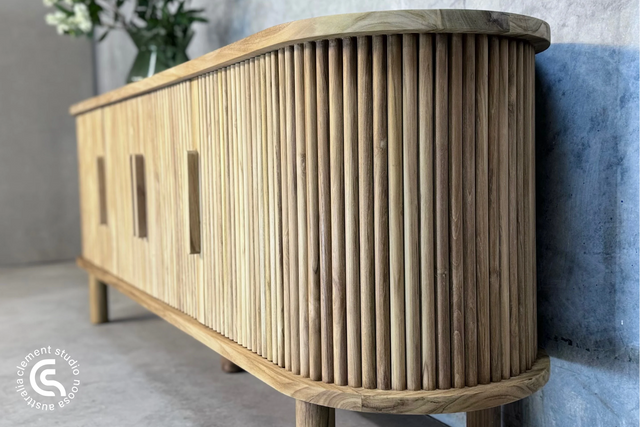Fluting and Ribbing: The Latest styles in Kitchen Island Benches and Buffets
In the ever-evolving world of interior design, the details often make all the difference. One trend that's making waves in kitchen design and furniture pieces, particularly in kitchen island benches and buffets, is the use of fluting and ribbing. These design elements, with their subtle yet striking textures, add depth and visual interest to any space. Let's explore what sets fluting apart from ribbing, and how the choice between preformatted panels and individualized solid timber ribbing impacts quality and design.
Understanding the difference between Fluting and Ribbing
Fluting refers to a series of shallow grooves or channels carved into a surface. These grooves are typically vertical and evenly spaced, creating a delicate play of light and shadow. Fluting has a rich history in classical architecture and design, where it was used to add texture and elegance to columns and furniture. Today, this technique is being modernized in kitchens and dining spaces, adding a refined touch to cabinets, kitchen islands, and buffets.
Ribbing, on the other hand, is similar in that it involves a series of lines or raised elements, but instead of carved grooves, ribbing features protruding ribs or bars that stand out from the surface. Ribbing can be both vertical and horizontal, offering more flexibility in design. The ribs can vary in thickness and spacing, which allows for a more dynamic and pronounced textural effect compared to fluting.
Fluting vs. Ribbing: Which One to Choose?
While both fluting and ribbing create texture and visual interest, the choice between the two often comes down to the overall design aesthetic and the effect you want to achieve.
Fluting tends to be more subtle and is often used to create a refined look. It’s perfect for those who appreciate understated luxury and want to add a touch of sophistication without overwhelming the space.
Ribbing is bolder and can create a more dramatic effect. It’s ideal for contemporary or modern designs where a strong visual impact is desired. The pronounced texture of ribbing can also add a tactile element to the space, inviting people to interact with the surfaces.
Preformatted Panels vs. Individualized Solid Timber Ribbing
When it comes to implementing fluting or ribbing in your kitchen or dining space, one major consideration is whether to use preformatted panels or individualized solid timber ribbing. Each option has its own set of advantages and drawbacks, impacting both quality and design.
Preformatted Panels:
Preformatted panels are factory-made and often mass-produced. They are designed to mimic the look of fluted or ribbed surfaces and are usually made from materials like MDF (Medium-Density Fiberboard) with a veneer finish. The main advantage of preformatted panels is that they are cost-effective and easy to install. They offer a quick solution for those looking to achieve a textured look without the need for skilled labor.
However, preformatted panels may lack the depth and authenticity of real wood. The grooves or ribs are typically shallower and more uniform, which can sometimes result in a flatter, less dynamic appearance. Additionally, because they are not made from solid wood, they may not be as durable over time, especially in high-traffic areas like kitchens.
Individualized Solid Timber Ribbing:
Individualized solid timber ribbing is crafted from high-quality timber, where each rib is cut and applied separately. This method allows for greater customisation in terms of the thickness, spacing, and depth of the ribs, creating a truly unique and bespoke look. The use of solid timber adds a richness and authenticity that preformatted panels simply can’t match. The natural grain of the wood adds character and warmth, and the depth of the ribs creates a stunning interplay of light and shadow, enhancing the overall aesthetic. Check out the beautiful Grange Sideboard as an example of this.
While individualised solid timber ribbing is undoubtedly more labor-intensive and therefore more expensive, the investment often pays off in terms of durability and longevity. Solid wood can withstand wear and tear better than veneered MDF, making it a more practical choice for kitchens and dining spaces.
Choosing the Right Option for Your Space
When deciding between preformatted panels and individualized solid timber ribbing, consider your budget, the desired aesthetic, and the functionality of the space. Preformatted panels might be suitable for a budget-friendly renovation or for areas that don’t see heavy use. However, for those looking to create a high-end, custom look with longevity in mind, investing in individualized solid timber ribbing is well worth it.
Ultimately, whether you choose fluting or ribbing, preformatted panels or solid timber, these textured designs are sure to add a unique element to your kitchen or dining space. As with any design choice, the key is to find what resonates with your personal style and meets the practical needs of your home.
Incorporating these trends thoughtfully can transform your kitchen island benches and buffets into statement pieces that are both functional and beautiful, adding a touch of contemporary flair or timeless elegance to your home.

